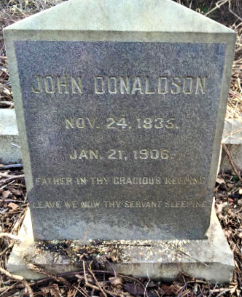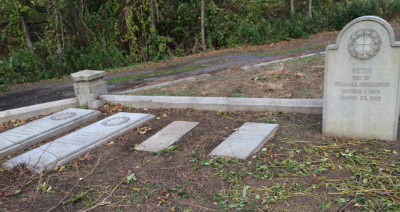Title: Coal mine owner, pipe manufacturer, bank president
Birthdate: November 24, 1835
Death Date: January 21, 1906
Plot Location: Section 27, Lot 100

Some people see a man who became wealthy on his own and claim “he may not have been born rich, but he had a head start.” John does owe a great deal to the smart decisions and entrepreneurial spirit of his father, but he made his own path and created his own legacy.
John’s Father
William Donaldson came to the coal mines of Pennsylvania having a “head start” of his own. He grew up in England where he joined his father working in lead mines. He married the daughter of a miner and purposely came to Tamaqua, Pennsylvania by way of Philadelphia in 1830. The potential of the coal region, especially Schuylkill County, had become well known. The original residents of the area were farmers but when anthracite coal was discovered beneath their fields in 1817, everything about Tamaqua’s life and economy changed.
William started out as an inside superintendent of mines owned by the Little Schuylkill Company, but determined he could launch his own operation. He made a deal with the company to sink a 360 foot shaft and then lease it from them. It was in the early years of mining when individual coal company ownership was thriving. By 1849 his operation employed 70 men and produced 20,000 tons that year.
John learned his father’s business and also sat under his father’s preaching for a time. William started a church in his home the same year they arrived and conducted services for a number of years before a separate building was erected. It was the very first “Primitive Methodist Church” in America. William brought the denomination’s beliefs and doctrine of good works with him from England.
By 1850 John had four sisters and two brothers, finished school, and worked as a clerk, perhaps at his father’s business. That year his father started the first bank in town, the Anthracite Bank of Tamaqua, and served as president until his death.
That year his father started the first bank in town, the Anthracite Bank of Tamaqua, and served as president until his death.
That day arrived In the summer of 1859. William, John, and three employees were inspecting the mine when they were caught in an explosion. John and the others were burned but his father died. Because he knew the business so well, John became both a mine owner and bank president at age 23. He was living with his mother, two younger brothers, a younger sister, and a servant at the time, and was listed as a coal merchant in the 1860 census.
He was living with his mother, two younger brothers, a younger sister, and a servant at the time, and was listed as a coal merchant in the 1860 census.
Shortly after that census was taken, John took Emma Priscilla Crook to be his bride. Shortly after that, in 1861, William J. Donaldson was born, named after his grandfather. Before the decade was finished they welcomed two more boys, Henry and Eddy, and a girl named Frances but called Fannie.
John’s Cousin
Several months before John’s father died in 1859, George Ormrod came from England to visit his Uncle William. He was 18 years old, a younger cousin of John’s by about four years, and William persuaded him to stay. George worked at the mines and soon found himself operating some of them, presumably in partnership with his cousin, John. They both became very wealthy, but the industry was about to change dramatically.
After the Civil War, a subsidiary of the Philadelphia and Reading Railroad Company purchased 70,000 acres of coal land in Schuylkill County. It signaled the start of a gradual decline in the number of small mine owners, people like the Donaldsons who displayed their Christian values by the way they treated their employees. The new mining companies recruited immigrants, mostly from Ireland, paid them less than they deserved, and treated them harshly.
By 1870 George had a family and built a beautiful home in Tamaqua; John moved his family to Philadelphia but still listed his occupation as a coal operator. The cousins were about to face a decade of trouble. Workers tried to organize, and that spawned the famous Mollie Maguire movement among the Irish workforce in the coal fields. Adding to labor unrest and violence was the Panic of 1873, one of the worst depressions in the nation’s history.
George sold his coal business and moved to Allentown by the end of the decade, investing in a blast furnace in Emmaus, five miles south. John had diversified as well. He was listed in the 1878 Philadelphia city directory as president of Bright, Thomas, & Co. but the nature of that business wasn’t identified.
The Iron Business
John and George then joined forces in 1883 to form the Donaldson Iron Company in Emmaus. They specialized in cast iron pipes, mainly for municipal water and gas lines. John remained in Philadelphia as president, while George was on site as manager and treasurer.
The company grew to employ 700 people, the largest employer in town, owning 71 acres of land and producing 50,000 tons of cast iron a year. Their business capitalized on the need for natural gas lines during the Industrial Revolution, and for the expansion of water and sewer systems in urban areas. It prospered until the second World War when a shortage of iron for domestic use forced it to close in 1943.
As successful as John’s namesake company was, he wasn’t entirely done with coal. Instead of mining it, he pivoted to the retail end of it. This 1890 city directory listing shows![]() his partnership in the sale of coal at 226 Walnut Street. His entrepreneurial spirit was shared by his sons, William and Harry; that same directory lists them doing business as Donaldson Bros. & Co. coal dealers, at 308 Walnut Street.
his partnership in the sale of coal at 226 Walnut Street. His entrepreneurial spirit was shared by his sons, William and Harry; that same directory lists them doing business as Donaldson Bros. & Co. coal dealers, at 308 Walnut Street.
John’s Death
As many Philadelphians did, John and Emma enjoyed vacationing at Atlantic City, New Jersey, and likely owned a second home there. That’s where John was when he died, relaxing at the shore on a winter’s day in 1906. Emma held his funeral in Philly less than three months after the funeral for their son Harry.
She had John’s stone inscribed, “Father in Thy gracious keeping, leave we now thy  servant sleeping.” She passed away in 1911, and her stone the children chose the phrase, “not changed but glorified.” They were all buried with Eddy, who died as an infant, here in Section 37.
servant sleeping.” She passed away in 1911, and her stone the children chose the phrase, “not changed but glorified.” They were all buried with Eddy, who died as an infant, here in Section 37.
John’s brother William F. Donaldson, his wife, and three of their children are in the same lot. All but one have horizontal “ledger” graves, shown here . Francis Donaldson, a fourth child of brother William’s, was mistakenly placed next to John’s daughter Frances (“Fannie”).
All but one have horizontal “ledger” graves, shown here . Francis Donaldson, a fourth child of brother William’s, was mistakenly placed next to John’s daughter Frances (“Fannie”).
She was the only child of John and Emma that never earned any income at all. Fannie spent her inheritance as a single socialite, living in some upscale rentals in Manhattan, and sailing almost annually to Europe. She didn’t take any of it with her, of course, when she died in 1947. The only member of John’s family not joining them at Mount Moriah was their son, William, who was buried in New Jersey.

Support the Friends of Mount Moriah
Help us in our mission to restore and maintain the beautiful Mount Moriah Cemetery by donating to our cause or volunteering at one of our clean-up events.

